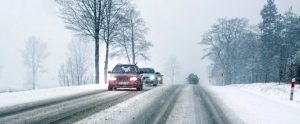As temperatures drop, driving conditions become more dangerous. Even minor snowfall can create gridlock and lead to accidents. If you live in or will be traveling to an area with harsh winter conditions, you must be prepared. A helpful winter driving safety tip is to winterize your car, so you are ready for the snow and ice.
Being proactive will help keep you and your loved ones safer on the road. However, nothing can protect you from every other driver on the road. If someone else’s negligence results in an injury collision, you may need to search for a personal injury attorney to learn how they can help.
To help you prepare for the upcoming winter season, here are some helpful winter driving safety tips and what you need to know about winterizing your car.
Safety Tips
When you are driving in harsh weather, it’s imperative to be extremely cautious. If you are not used to driving on snowy or icy roads, practice in an open area or empty parking lot. Also, remember some tips for driving in the snow.
To start, you should always drive more slowly in bad weather. Even if the storm doesn’t seem too bad, there could be a patch of black ice that is not immediately apparent.
Always try to stay calm and focused. Do not speed up and slow down quickly. Practice accelerating and decelerating slowly. That can prevent you from losing control of your vehicle. Never turn cruise control on during a storm. That can also lead to an accident if conditions suddenly change.
Under normal circumstances, you should stay no less than two seconds behind another vehicle. During the winter, you should raise that to around six to eight seconds. Maintaining the appropriate distance from vehicles in front of you and not driving too fast for the conditions can help keep you safe when driving in the ice or snow.
How to Winterize Your Car
Winter driving safety preparation starts long before the snow starts falling. Your vehicle must be ready before you are faced with a winter-weather-related emergency. Websites like Carmax have helpful checklists and snow driving tips.
Before winter arrives, make sure to:
- Thoroughly wash your vehicle and clean out any build-up;
- Wax your car to protect your paint;
- Consider snow tires or all-weather tires depending on where you live;
- Replace your windshield wiper blades;
- Make sure your tires are properly inflated;
- Have all fluids changed and at proper levels, including washer fluid;
- Check brakes and replace if necessary;
- Flush your heater;
- Check your battery and consider installing one with a higher CCA for winter; and
- Make sure your rear defroster works.
You should also have a winter safety kit in your vehicle. In your winter safety kit, consider keeping:
- Warm clothing
- Boots with socks
- Blanket
- Non-perishable foods
- Drinks
- Flashlight with batteries
- Extra antifreeze
- Jumper cables
- Bag with sand
- Shovel
- First aid kit
- Flares
- Matches
- Ice scraper
- Car tool kit.
Avoid pouring hot water on your windshield or side windows to defrost the ice. That can cause the glass to expand. If the glass expands too rapidly, there is a risk of cracking. Instead, consider creating a mix of three parts vinegar and one-part water to spray on the windows before they get icy. The vinegar’s acidity can help reduce any frost and ice build-up.
Best Ways to Stay Vigilant
Always try to keep your gas tank at least half full during the winter months. A full tank can help reduce condensation and keep gas lines from freezing. If you break down somewhere, you can turn the vehicle on once an hour or so to keep yourself warm until help arrives.
Black ice is virtually impossible to see, but watch the road closely for warning signs. When temperatures dip to 32 or below, you should be watching for glossy patches on dry roads. As you drive, watch cars in front of you. If water sprays up from their tires, you are probably fine. If there is no spray coming off the other vehicles, pay close attention, as it could be a sign of black ice.
If you hit a patch of black ice, take your foot off the accelerator, but don’t hit the brakes. If you slam on the brakes, it will lock your steering and send you drifting. Hold your steering wheel steady and make only small corrections as necessary.
If possible, stay off the road on the first snow of the season. According to Icy Road Accidents, fatal accidents are 14% more likely on the first snowy day. If you must go out, remember these winter safety driving tips and stay alert. Always remain vigilant and watch the cars around you in case you need to take evasive action.
Stay Home
If you live in the South, everyone on the road is not use to driving in icy or snow conditions. Just about everything shuts down, when we have below freeing weather conditions. Make sure to stay safe and just stay at home if the conditions are not favorable. Most schools in the South close down at the mention of snow and ice.



Leave a Reply